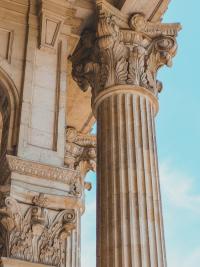The Three Great Pillars
10 August 23
Pillars or columns have always held a peculiar and important place in Freemasonry and are objects of great interest to the Craft in general.
Eleven pillars are spoken of in Masonry – two appear in the ‘Old Charges’, two were placed at the porch or entrance to King Solomon’s Temple, two were allotted to the wardens, and five, including the three which support a mason’s lodge, are mentioned in the Noble Orders of Architecture.
As Fellowcrafts, we are directed to study the symbolism mainly of the five Noble Orders of Architecture, but more especially the three original ones – the Ionic, Doric and Corinthian, they being representative of the three pillars on which a mason’s lodge is supported: wisdom, strength and beauty.
The other two are the Tuscan and Composite. Tuscan is the first of the Five Orders but there is no certainty as to its origin. It was not used by the Greeks, it’s unlikely the Romans invented it and it was probably used by the Etruscans. The Composite, also called the Roman and the last of the five, is a combination of the Corinthian and Ionic.
The Doric is the first and simplest of the three Greek Orders. It was evolved by the Greeks of the Western territories at the same time as the Greeks of the Eastern territories were creating the Ionic Order. The true Doric style is found in Greece, Sicily and Southern Italy, the finest example being the Parthenon on the Acropolis at Athens.
This Pillar exhibits the proportions, strength and beauty of the body of a man. It is symbolical of strength and is allotted to the Senior Warden, who in ancient times was responsible for the actual operations of the workmen according to the plan of the Master. The Senior Warden must possess strength to enable him to perform the important duties allotted to him. Strength without wisdom is dangerous, therefore he is directed at his investiture to act in conjunction with the Master. Every member of the lodge is engaged under the direction of the Senior Warden in building the spiritual temple of his own character, perfect in all its parts and honourable to the builder.
The Ionic is placed second and the Romans adopted it but treated its details with less beauty and refinement. The true home of the Order was in Asia Minor and it is suggested it was fashioned on the proportions of the female figure with a more slender look, scrolls hanging down like curly ringlets and festoons of fruit arranged in place of hair. Symbolic of wisdom, the Ionic is allocated to the Master who must possess that wisdom necessary to rule and govern the lodge efficiently and employ and instruct the brethren in Freemasonry.
The Corinthian is the third of the three Greek Orders and first appeared as a variant of the Ionic and was less used than the other two until fully developed by the Romans. The richness of its decoration appealed to Roman instinct and they used it more frequently in their buildings than any other Order of architecture.
Symbolical of beauty, this pillar is allotted to the Junior Warden. He is in charge when the sun is at its meridian, when life-giving properties and bright- ness are at their highest point. At this time of day work ceases for a period and peace prevails with general relaxation of mind and body so that pleasure and profit may be the result. The power to express beauty of thought, word and action is given to man alone of all the living kingdom and every brother must ensure that beauty adorns the inner man.
The next time you attend your lodge, think more about the five Noble Orders of Architecture, but more especially the three original ones, Ionic, Doric and Corinthian, they being the pillars on which a mason’s lodge is supported – wisdom, strength and beauty.
As appeared in the Autumn Freemason Magazine , 2012.



